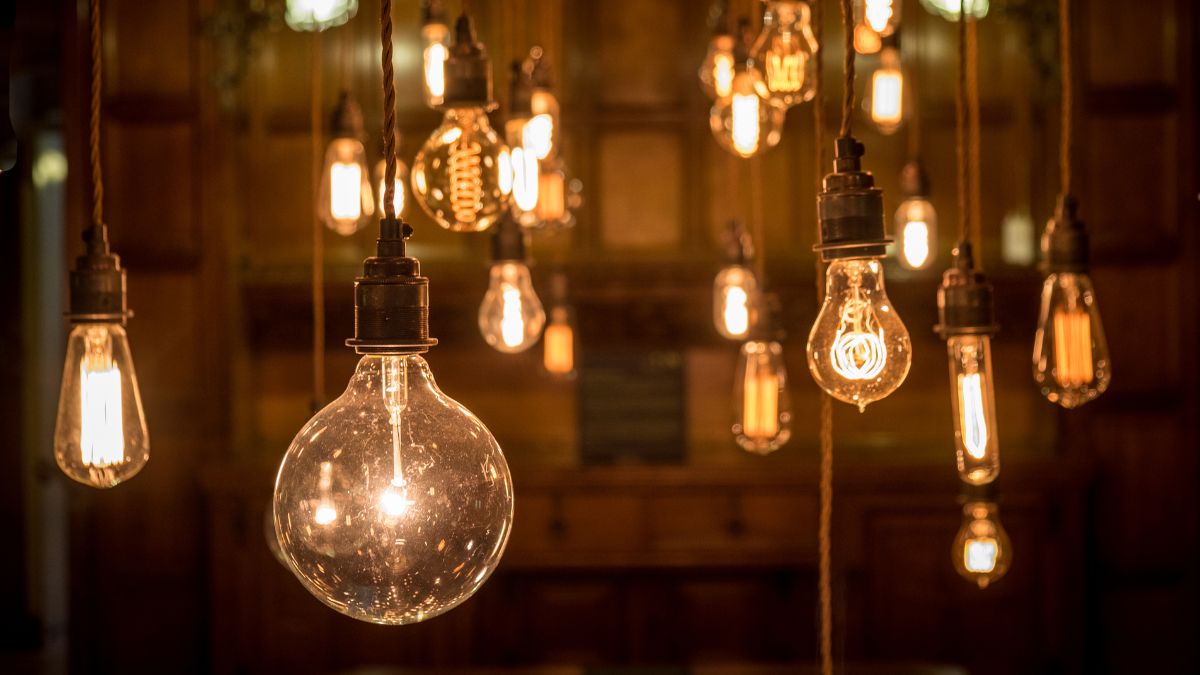If you've recently found yourself in the market for new light bulbs, you've probably been faced with what seems like endless options. Recent innovations have brought us all sorts of new lighting technologies .
From light bulbs designed to react to sound waves to ones designed to fight deadly bacteria (seriously, they exist), what was once a simple source of light continues to evolve.
But when you simply need a new bulb for your bedside lamp , how do you know if you're making the right decision? Which bulbs are designed to be more environmentally friendly and help us reduce our electricity bills?
Below we address these and other frequently asked questions about light bulbs.

What are my light bulb options?
In a word: a lot! But here are three of the most popular:
Incandescent light bulbs
These are the old-fashioned, "typical" light bulbs that many of us grew up with. They aren't very energy efficient and don't last long.
Compact fluorescent bulbs (CFL)
It's the "spiral" bulbs that come to mind when we think of energy-efficient light bulbs.
LEDs
LED bulbs are very energy efficient but retain the look and feel of an incandescent bulb.
Incandescent bulbs, CFLs, and LEDs all use different amounts of energy. But we think LED bulbs are the ones worth paying attention to.
What are LED bulbs?
Technically, LED bulbs aren't light bulbs. LED stands for " light-emitting diode ." They are tiny semiconductors (diodes) encased in plastic to protect the elements and focus the light.
According to Dictionary.com , a diode is "a two-terminal semiconductor device, usually allowing current to flow in only one direction." Current flows in through an anode (+) and out through a cathode (-). LEDs don't even have filaments like light bulbs.

How are LEDs different from incandescent lamps?
When we talk about a "regular light bulb," we're referring to an incandescent light bulb, the type that has been around since Thomas Edison patented his invention in 1879. These bulbs have filaments that glow, producing both heat and light when energy passes through them.
LEDs, on the other hand, have electrons that flow to create photons —the light we can see. Photons generate almost no heat. LEDs also require much less energy to create the same amount of light as incandescent lamps, and they last much longer.
Do LEDs save energy?
LEDs consume much less energy than incandescent bulbs because the light from diodes is much more energy efficient than that from filaments.
LED bulbs use over 75% less energy than incandescent bulbs . At lower wattages, the difference is even greater. Bright LED lights use only 11 to 12 watts while creating a light comparable to that of a 50-watt incandescent bulb.
Another advantage of LEDs is the "inconvenience factor." LEDs last much longer than a regular light bulb.
What about CFL bulbs?
CFL bulbs are also more efficient than incandescent bulbs because of the way they produce light. According to Energy Star, "in a CFL, an electric current passes through a tube containing argon and a small amount of mercury vapor.
This generates invisible ultraviolet light that excites a fluorescent coating (called a phosphor) inside the tube, which then emits visible light."
You may know CFLs as the light bulbs that start out dim and take a while to warm up to full brightness.
However, once electricity starts flowing inside, these bulbs use about 70% less energy than incandescent bulbs. Therefore, they are not as efficient as LEDs, and their lifespan is shorter.
But don't LEDs cost more?
The initial cost of an LED was once about twice that of an incandescent bulb. But costs have come down, and it's now difficult to find non-LED bulbs.
In fact, they are so much more efficient than incandescent bulbs that they save money in the long run. This has made them the benchmark product for the lighting industry .
The average American household has about 40 light bulbs . Replacing all of those bulbs with LEDs could save $300 a year on energy costs (if they're incandescent bulbs—if you have CFLs, you can wait until they burn out to replace them with LEDs). This more than offsets the slightly higher initial cost of LEDs.
Do the quality and cost of bulbs vary?
Originally, many people preferred CFLs to LEDs because they emit a wider beam of light, making them more suitable for streetlights. But LED technology is constantly improving, and LEDs now emit a wider, warmer light.
What makes LEDs and CFLs much more efficient than incandescent bulbs is the amount of energy they use to create a certain amount of light. When it comes to power, no two bulbs are the same.
A 1,000-watt light bulb, regardless of type, will use the same amount of energy, but it will emit a completely different level of light with that energy. This is why it's essential to consider brightness, or lumens, when comparing bulbs.
A lumen is a measurement of light . If LEDs, CFLs, and incandescent bulbs all have the same lumen, they have the same brightness. Lumens are listed on the bulb packaging.
To get the most efficient light, find your desired lumen output (the higher the output, the brighter the light) and choose the bulb with the lowest wattage. LEDs will likely be the winner in all cases.
Another advantage of LEDs is the "inconvenience factor." LEDs last much longer than a regular light bulb , saving you the hassle of searching for the drawer where you stored the bulbs—not to mention the money you have to spend on new bulbs. According to manufacturers, an LED lasts about 10 years, or 100,000 hours of continuous use.

Can I save money with LEDs?
Most people now understand that LEDs save energy, but they may still be hesitant to pay the higher price of LEDs. But the rewards are worth it.
Let's do a simple calculation to compare the efficiency and savings of different light bulbs. For ease of calculation, we'll assume we have a 100-watt incandescent light bulb and that a kWh of energy costs 15 cents.
Calculating costs for incandescent bulbs
A 100-watt incandescent light bulb operating for a full year would consume 876 kWh of energy, costing €131.40 in electricity costs. Keep in mind that you'll also need to replace the bulb, probably about once a month.
Calculating costs for CFL bulbs
A 25-watt CFL bulb provides the same brightness as a 100-watt incandescent bulb, but uses only 216 kWh of energy over the course of a year. That's €32.40 in energy costs, and you'll likely only have to replace the bulb twice.
Calculating costs for LEDs
A 16-watt bulb would emit as much light as a 100-watt incandescent bulb, and it would only consume 140 kWh of energy per year. The electricity cost would be only € dollars, and an LED would last all year .
Everyone's numbers will vary slightly depending on the cost of electricity in their community, so start replacing your light bulbs with LEDs! They really do make a difference.
If I replace my bulbs with LEDs, what should I do with the old bulbs?
Don't throw them away! You should always recycle light bulbs, partly for safety reasons—CFLs contain mercury vapors that could be released into the atmosphere and runoff if the bulb breaks in a landfill—and partly for efficiency reasons.
Some parts of the bulb can be reused. Collect your bulbs carefully and take them to your local hazardous waste center.
LEDs do not contain mercury and can therefore legally be thrown in the trash , but it is always better to recycle them. Take their positive impact on the environment to the limit!






Leave a comment
This site is protected by hCaptcha and the hCaptcha Privacy Policy and Terms of Service apply.